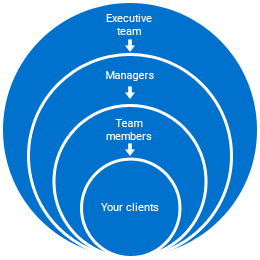Your leadership style: The key to a growing, profitable business
To grow and become more profitable, your business needs to:
- innovate and provide new value to customers
- become more efficient, reduce costs and improve the customer experience
- seek new markets
That’s not a small list. The underlying key element in achieving these goals is the leadership style you foster in your company.
A manager’s role
The following diagram shows the relative influence of your team on customer experience and how support should flow in your organization.

As you notice, the senior executive team and managers have no direct impact on your customers, but have a significant impact on supporting the frontline employees who produce value for customers.
Too often, we see managers tackling quality or efficiency problems by developing initiatives without the involvement of the people who actually do the work and need to implement the directives. Often, the result is deterioration rather than an improvement of the situation!
A manager who is a catalyst for change will be relentless in identifying and correcting sub-standard output (defects, late delivery, etc.). But he or she will do so with the full involvement of team members. Together, they strive to understand the root causes of problems; find innovative solutions; and continuously measure improvement. Toyota calls this “respect for people.” By involving team members, you improve your results while developing the skills of team members.
Successful leadership behaviors
The following is a quick list of successful leadership behaviors to create a culture of continuous improvement in your business. You may want to use this list to quickly assess your own leadership style.
- I have a clear vision of where I want to take our business. I share this vision daily with team members.
- I spend time on the floor every day interacting with team members.
- I devote adequate time to recruiting employees and helping them develop into the leaders of tomorrow.
- When mentoring, I avoid preaching and, instead, use questions to make team members reflect on their behaviour (the Socratic method of teaching).
- I keep up to date in my field and share my knowledge with team members.
- I ask where in the process we have failed, not who has failed.
- I use operational metrics to measure the efficiency of our processes rather than financial results.
- I “walk the talk” every day when it comes to company values.
- I listen more than I talk and think before I talk.
- I see problems as opportunities to make my team grow, not as a burden to be endured.
Your challenge
Many entrepreneurs started their business in their garage. With time and hard work, they became good at many tasks (from accounting to marketing to repairing machines). Your challenge as an entrepreneur is to learn to let go as your business grows and let your team take on more and more responsibility.
I call this a challenge because it’s hard to let go of something you’re good at and proud of doing. However, overcoming this challenge is the gateway to building a strong, growing business.
At BDC, we have clients who will work seven days a week, complaining no one else is able to do the tasks. This is the path to stagnation. Growth and often profitability depend on leaders making time to mentor team members and delegate responsibility to them, allowing them to find solutions to problems and make decisions.
The enlightened manager
Leaders who accept to evolve in this way will find they have something new to be proud of. You’ve contributed to the growth of individuals and your organization.
Entrepreneurs often equate operational efficiency with the tools used to improve performance. However, tools represent only 20% of the effort required to sustain continuous improvement in a business. The other 80 % involves changing leadership practices, behaviors and ultimately your mindset.
Managers should lead by example while coaching and empowering employees. This is the mindset you and your managers need. Sustained continuous improvement will follow.